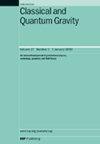跨越宇宙时间的聆听:未来十年地面和太空任务的标准警报器
IF 3.7
3区 物理与天体物理
Q2 ASTRONOMY & ASTROPHYSICS
引用次数: 0
摘要
哈勃参数的精确测量将使宇宙学标准模型的严格测试成为可能。标准的警报器,通过引力波观测致密双星合并所测量的光度距离,有望在未来十年独立提供这样的测量。地面和天基引力波观测站,LIGO-Virgo-KAGRA (LVK)网络和激光干涉仪空间天线(LISA),不同类型的标准警报器将在广泛的红移范围内施加限制。在本文中,我们预测了标准警笛哈勃参数测量的精度,并比较了各种情况,说明了系统不确定性的主要来源。具体来说,当LVK和LISA标准警报与来自电磁(EM)对应观测的精确红移测量相结合时,我们发现对H0有2%的约束,对z = 1处的H(z)有1.5% - 3%的约束,对z = 7处的H(z)有3% - 5%的约束。当包括没有EM对应的标准警报器时,我们没有发现显着的改进,但它依赖于黑洞质量分布的特征,并且如果不适当地解释这些特征可能的红移演化所引入的潜在系统学可能会进一步降低测量精度。本文章由计算机程序翻译,如有差异,请以英文原文为准。
Listening across the cosmic time: standard sirens from ground- and space-based missions in the next decade
Precise measurement of the Hubble parameter will enable stringent tests of the standard model for cosmology. Standard sirens, using the luminosity distances measured by gravitational-wave observations of compact binary mergers, are expected to provide such measurements independently in the next decade. With the ground- and space-based gravitational wave observatories, the LIGO-Virgo-KAGRA (LVK) network and the Laser Interferometer Space Antenna (LISA), different types of standard sirens altogether will place constraints across a wide redshift range. In this paper, we forecast the precisions of standard siren Hubble parameter measurements and compare various scenarios, accounting for the dominant sources of systematic uncertainty. Specifically, we find a 2% constraint on H0, a 1.5%−3% constraint on H(z) at z = 1, and a 3%−5% constraint on H(z) at z = 7 when combining LVK and LISA standard sirens with precise redshift measurements from electromagnetic (EM) counterpart observations. We do not find a significant improvement when including standard sirens with no EM counterpart, but which rely on features in the black hole mass distribution, and the potential systematics introduced by the possible redshift evolution of such features could further degrade the measurement accuracy if not properly accounted for.
求助全文
通过发布文献求助,成功后即可免费获取论文全文。
去求助
来源期刊

Classical and Quantum Gravity
物理-天文与天体物理
CiteScore
7.00
自引率
8.60%
发文量
301
审稿时长
2-4 weeks
期刊介绍:
Classical and Quantum Gravity is an established journal for physicists, mathematicians and cosmologists in the fields of gravitation and the theory of spacetime. The journal is now the acknowledged world leader in classical relativity and all areas of quantum gravity.
 求助内容:
求助内容: 应助结果提醒方式:
应助结果提醒方式:


